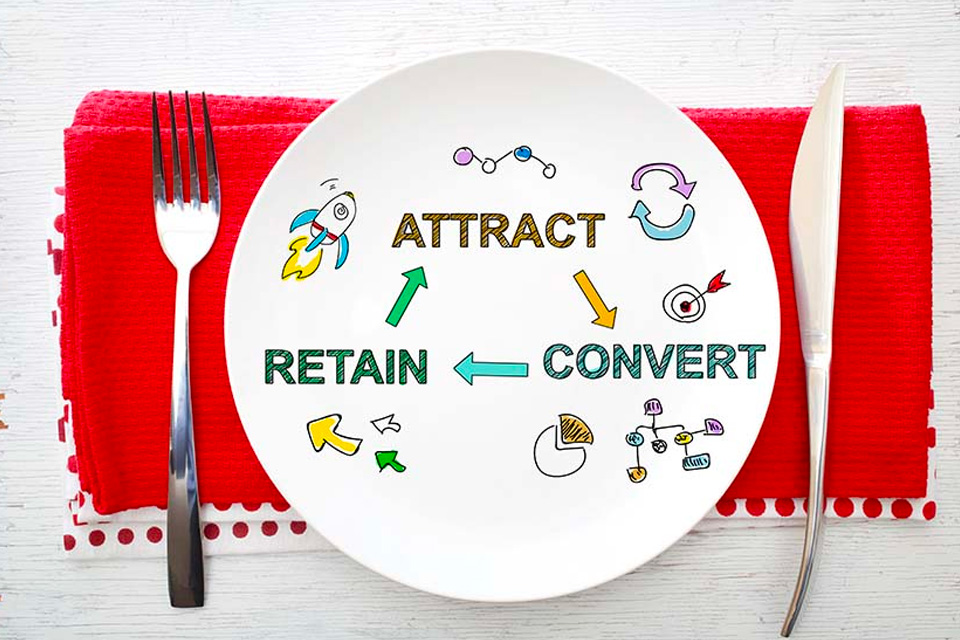If you’ve been in business for any length of time, you know there are only three ways to bring in sales to your company:
- Find new clients
- Sell more to each client that comes through your door
- Bring back existing clients again and again
And it doesn’t take more than a moment or two to realize that your most expensive marketing method is to find new clients. You have to win them over and convince them you’re the best.
Instead, savvy marketers know that the real way to grow a business is by creating happy clients. Happy clients spend more. Happy clients visit your business more. And happy clients refer their friends.
A recent study by BIA/Kelsey showed that small business owners prioritized their marketing dollars towards retention efforts. More than half of their revenue comes from repeat customers, and when they come back, they are spending 67 percent more than the average new customer.
While you should never ignore attracting new customers into your business, it is clear that by spending time considering how you market to customers once they notice you, you can quickly see your revenues go up.
When a customer is purchasing for you, it’s the best time to teach them more about what you have to offer.
And by developing a solid plan to keep your name in front of them, you can ensure they will keep spending with you months, even years into the future.
You might have a marketing plan in place to bring in new customers. How well is it working for keeping existing clients happy?
With every marketing dollar you spend, are you focusing in on building up your brand? Or are you teaching your best customers how to develop a deeper relationship with you?
While you don’t want to ignore your new customers, your marketing dollars will be well spent by developing strong upselling and retaining programs too.
There are a few things to consider.
How To Upsell To Customers Who Come Through Your Door
Upselling is a sales technique that helps persuade customers to purchase an upgraded version of what they originally came to you for, or adding on additional products or services for the purpose of making a bigger sale.
In the ecommerce world, you’ll often find the “also bots” that go along with a purchase. Ever seen a recommendation attached to something in your shopping cart with the term “people who bought this product also bought this” with it? Yep, that’s the “also bots” in play, attempting to upsell you in order to increase the order value and maximize profits.
Upselling is important to a business to improve our shopping experience. Especially online, retailers can rely on upselling for several reasons:
It helps deepen relationships with customers
Upselling is not a dirty sales tactic. If it focuses on helping your customers by making better, more informed decisions, it will deliver more value and make them feel like they got a better deal. Making a customer happy that also generates additional revenues is win-win for everyone.
It’s easier to upsell than acquire new customers
Lead generation is an expensive process. The probability of selling to a customer who knows you and is sold on your concept is 60 to 80 percent more likely to purchase than a new prospect.
Upselling increase Customer Lifetime Value (CLV)
Customer Lifetime Value is the net profit contribution a customer makes to your company over time. A higher CLV means each customer generates more revenue to your business over its lifetime without you having to invest anything extra. By spending more in the beginning to keep a customer happy, you can ensure they shop with you again and again, for months or even years down the road.
Upselling is not meant to be one-sided. Do it solely to increase revenue, and you’ll lose value and faith within your customer base. What shouldn’t you do?
Never Fake Being Personal
The online world has allowed us to automate just about everything. Send a newsletter to the masses? It’s easy to do. Create instant response messages? You can do that too. Just about every step in your sales and marketing process can be automated to appear personal even if it’s not.
And if you don’t do it carefully, your customer base will know it.
Try automating an email that says “Dear Friend” followed by a “personalized” note that states “We’re reaching out to our customers to personally tell you …” and see what kind of response you get.
There are ways to “personalize” your contacts without coming on too strong. Creating special offers or asking for feedback based on the data you collect can be used to deepen the connection.
Don’t Make Upsell An Afterthought
Have you ever felt pressured to upgrade? Of course, we’ve all been in that position. When someone is sold on something and are suddenly thrown into a situation where they’ll have to spend more money, the offer can seem less than stellar.
If you sell a product or service, you should have every faith in the product or service being offered. If a customer chooses to walk away with just that, you should be happy with the sale.
The goal of upselling is to ensure the customer makes the right choice based on what information you have about the customer. Every case is different. What works for one may not be right for another.
That comes down to understanding your products and services and building that into your marketing. Ever see “best seller” or “most popular choice” in a page you click to? These marketers are directing visitors to buy without coming on too strong. Other options are available to ensure everyone gets what they want. Yes, it may cause a lot of people to upgrade from the bottom up. But showing the benefits ensures the visitor gets what they want.
Dig Deeper
How Digital Personal Assistants Will Impact Your Marketing
The Rise Of Connected TV And How To Use It In Your Marketing Strategy
How To Build A Strong Retention Program
Statistics show that 80 percent of your future profits come from just 20 percent of your existing customers. That makes the most valuable part of your business come from your list.
What are you doing to ensure that’s a strong list?
Start By Predicting Your Customers’ Needs
Customer retention is all about a quality experience. And most of that experience comes from good communication.
Are you conscious of every connection you make and what you are telling your customer base? Your branding and your message should come through loud and clear in your social media, email, text, web chats, web content, print advertising, customer service. As the number and quality of your communication channels increase, user expectations rise too.
If you want to retain a customer, take care in creating trust in everything you do. You can do that by predicting questions they have and providing the answers long before they ask.
Then provide them in many different formats. They’ll welcome them and be grateful you care enough to share before they even need it.
Consider A Loyalty Program
Businesses create loyalty programs because they word. It creates incentives for more spending and rewards those that spend the most.
Successful loyalty programs boil down to whether you’re listening to what your customers are saying, and how attainable you’ll make what they truly want. The more you reward, the more they’ll spend.
Customer retention and upselling both require quality communication between you and your customers. Before you spend a big part of your marketing dollars on new products or services, ensure you have what it takes to give your existing client base what they are asking for. You’ll win every time.




